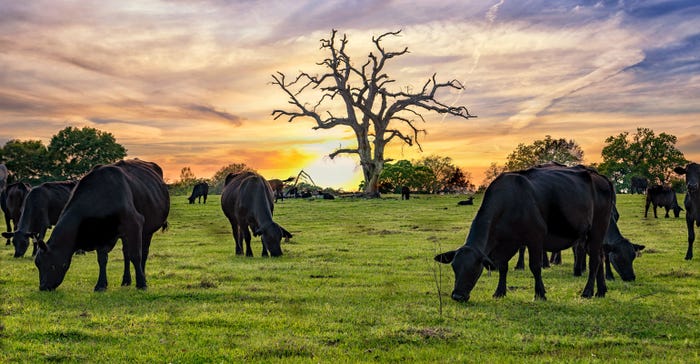Slideshow: Identifying the range of weeds you have is important to boosting profits for your operation.
March 5, 2021

A good grazing program is as important as a good vaccine, feed or mineral program for your cattle, says Jeff Clark, market development specialist, Corteva Agriscience Range and Pasture Business. Clark spoke recently during the Virtual BEEF Experience, where he dealt with some important topics involving pasture, and pasture health.
During his talk, he tackled three areas:
• Knowing weeds that may be toxic for cattle and horses
• Careful management of two valuable forages
• Avoiding parasites in cattle
The slideshow that accompanies this story offers a look at those toxic weeds in greater detail.
“What weeds do you have in your field?” Clark asked. “You want to look in the spring, summer and fall. And if you find a weed you’ve never seen before, get it identified before grazing livestock on it.”
He points to a simple spring weed, buttercup, that’s pretty in your pastures — but when cattle consume too much of it, it can be a headache for them.
The pretty buttercup can cause gastrointestinal irritation and even oral blisters in ruminants. For horses, Clark says it can even cause them trouble, too — though not the mouth blisters. That gastrointestinal distress may not kill a cow or calf, but it can reduce their appetite and affect gains.
He points to other weeds like snakeroot and poison hemlock. The latter stays in a fern stage until March and then flowers, and “every inch is toxic to grazing livestock,” Clark said.
The power of mint
Clark spent some time during his presentation to discuss Perilla mint — a plant that comes into grazing pastures and hayfields each summer. And later, when it enters its reproductive stage, the plant gives off a minty scent that attracts calves. It can be deadly.
“This is not a toxic plant that needs to hit a certain percentage of dry matter [to hurt an animal],” Clark said. “One plant can kill a calf.”
The symptoms don’t appear quickly — but by the time they do, the animals struggle to breathe, they’re in respiratory distress and they shut down. “You can see the animal react and contact your vet, but before they can get out there to help, it’s too late,” he said.
He added that if you have the plant and want to kill it, that takes special management, too. “Once you spray Perilla mint, the plant will try to survive,” he says. At that time, as the weed fights for its life, it becomes more toxic and more palatable as it is dying. It can draw more cattle and calves after you spray it.
If possible, he recommended removing cattle from the affected area of the pasture. Treat the pest, and then wait for it to die completely. “The rule of thumb is to wait until it is brown, down and you can crumble it up in your hand.”
Many plants are toxic
The toxicity of plants can be complicated. Perilla mint, buttercup and snakeroot all take their toll, but there are plants that are only toxic at certain life stages. Clark discussed two grasses that at some life stages are great sources of protein and total digestible nutrients — but if they head out? There’s trouble.
He highlighted two in the presentation — fescue and dallisgrass. “Both have high total digestible nutrients for livestock, and across the South, most people have these two grass species,” Clark said. “We do not want to get rid of them, but learn to manage them.”
When fescue develops its seed head, it becomes a breeding ground for a fungal endophyte that produces alkaloids that bind to blood vesicles, causing vasoconstriction. This makes it difficult for the animal to regulate its temperature, which, during hot weather, can reduce feed intake and cut gains. “Eighty percent of the alkaloids are in that seed head,” Clark noted. “If the seed heads are there, you start to have the issue.”
Animals impacted by the problem will demonstrate trouble when temperatures rise. Clark noted that you’ll find them trying to keep cool in ponds, creeks or under trees. And it will cut dry matter intake, which can decrease body condition and cut average daily gains.
Cuts in daily gains can create lower pregnancy rates, cause lighter weaning weights and more, Clark outlined. “You want to work with a pasture and range specialist to scout; and if you see the flag leaf, that’s a telltale sign of seed head development,” he says. “You can control the seed head and leave the fescue in a vegetative state, which is grazable without toxicity concerns.”
Dallisgrass creates problems at seed head development, too. When the seed head emerges, it can become the home for ergot. When cattle consume ergot, it causes neurological issues and impacts the animal's nervous system, Clark said.
That problem usually appears during late summer and early fall. Symptoms that develop include neurological disorders, like “dallis staggers.” It can also lead to animals being poisoned, aggressive behavior, collapsing, diarrhea and lower gains.
Controlling dallisgrass seed head development can help avoid this problem, too.
Cattle parasites and more
On a closing note of his presentation, Clark noted that pastures also contain parasites like worms that can significantly impact cattle health. He rattles off pests like barber pole worm, brown stomach worm and bankrupt worm.
“In the first 4 inches of grass, that larvae is waiting to be ingested,” Clark said.
While deworming products are popular, he added that overuse can lead to resistance. Pasture management can be a valuable tool here, too.
Tactics include rotational grazing, and interseeding of various forages that create more variety and an increase in legumes. “Watch that grazing doesn’t get too close to the surface,” Clark said, noting that overgrazing can lead to more pest problems in cattle. And if the conditions are droughty, cattle grazing too close to the ground can ingest dust that can lead to pneumonia as well.
“This is not an answer to everything, but leave enough forage to keep them off the ground, and you can help eliminate pneumonia and parasitic issues,” Clark said.
Here's a video about the Virtual BEEF Experience:
About the Author(s)
You May Also Like





